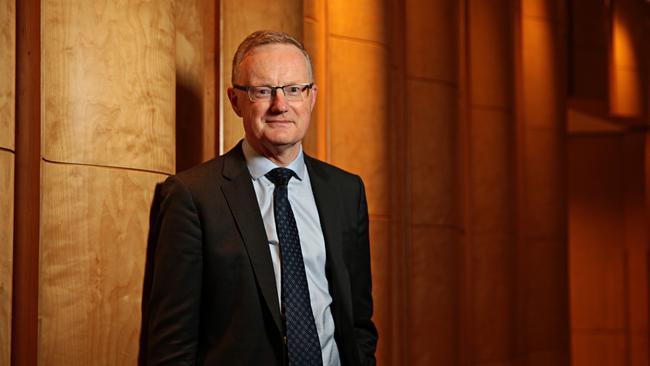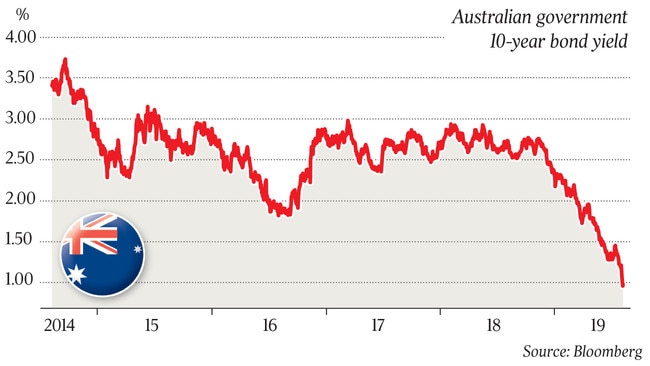Interest rates tipped to remain ultra-low for a decade
Investors are now betting that interest rates will remain radically low in Australia for up to a decade.

Investors are now betting that interest rates will remain radically-low in Australia for up to a decade.
With the Reserve Bank expected to cut the cash rate below 0.5 per cent within six months and potentially start unconventional policies such as quantitative easing in the years ahead, overnight indexed swaps now imply the cash rate will average 0.84 per cent for 10 years.
The pricing comes amid concern about a looming global recession after Germany’s industrial production contracted the most since 2009.
Australia’s benchmark 10-year bond yield hit a record low of 0.933 per cent yesterday before recovering to 0.98 per cent amid some improvement in the global risk appetite following China’s yuan fixing and trade data.
At these levels — and after taking into account inflation — Australia’s long-term bonds remain in negative territory. The normally-positive spread between Australian and US 10-year bond yields dived to minus 85 basis points last week — the most negative long-term yield differential since 1981 — a move that highlights the Australian dollar’s vulnerability to aggressive RBA interest rate cuts.
With RBA governor Philip Lowe flagging “an extended period of low interest rates” the yield curve is now the flattest since 2011.
As the restart of the US-China trade war dramatically increases the risks faced by an already fragile global economy, RBA governor Philip Lowe faces a grilling this morning by the House of Representatives Standing Committee on Economics about the effectiveness of the central bank’s strategy of pushing interest rates down toward zero, penalising savings and potentially reigniting Australia’s world-record debt bubble that was fuelled in part by aggressive interest rate cuts after the mining boom.
Together with expectations that the European Central Bank will not only cut its short-term interest rates but restart quantitative easing next month, the weak economic outlook for Europe saw German 10-year bund yields hit a record low of minus 0.61 per cent this week.
The slowdown in Europe, combined with aggressive interest rate cuts by central banks in the Asia-Pacific region this week and the latest threat to global supply chains from new US tariffs on China starting next month drove 10-year US Treasury yields down to a three-year low of 1.593 per cent before they bounced back to 1.73 per cent due to a weak 10-year Treasury bond auction.
“US-China trade tensions have certainly sparked concerns over a global growth slowdown and the decision by Asia-Pacific central banks to ‘go hard and early’ has provided further fuel to concerns of a global recession,” said Rodrigo Catril, senior forex strategist at NAB.

In what economists are now calling the greatest-ever rally in Australian bonds, benchmark 10-yields have fallen from around 2.8 per cent to 1.98 per cent since November last year, when risk aversion spiked as growth slowed and the trade war flared and the US Federal Reserve pressed ahead with interest rate hikes, before radically changing course along with other central banks this year.
“The rally in the 10-year Australian commonwealth government bond over the past year is the greatest in percentage terms since at least the mid-1980’s,” said David Plank, head of Australian Economics at ANZ.
“While there have been a few occasions when the outright level of yields has dropped by a little more over 12 months than has just occurred, this is the biggest percentage drop since at least 1986.”
RBC Australia chief economist Su-lin Ong said that while further fiscal and monetary stimulus was likely before the RBA ventures down the QE path, more public discussion of such unconventional policy was likely when the cash rate moves below 1 per cent.
“It needs to signal that there is further policy ammunition available as the official cash rate moves ever lower, that there is, effectively, no lower bound and that there are alternative measures if necessary,” she said.
“This will help keep bond yields low, credit markets well supported, and assist asset markets.”
She said Governor Lowe’s speech in late July was a “step in this direction” as it confirmed a “lower for longer policy stance and clear easing bias”.
She said it raised questions including an over-reliance on housing, potential to refuel borrowing and debt, intervention in markets and misallocation of capital, but “the risks need to be considered in the context of the alternative which is likely to be outright recession”.
Revised economic forecasts in the RBA’s quarterly Statement on Monetary Policy today are expected to show a downward revision to its economic growth forecast for 2019 and unemployment levels that may still be too high to achieve its inflation target by the end of 2021.
ANZ’s Mr Plank said RBA guidance for a long period of lower interest rates should provide enough support — mainly via a lower exchange rate — to allow quantitative easing to be avoided in the next 18 months barring a dramatic deterioration in the global economic outlook.
“But thinking over the longer term — over the next five to 10 years — QE of some sort is inevitable because we will be hit by a negative shock that requires a more significant policy easing than a cash rate of 1 per cent allows.
“I certainly can’t rule out QE being required over the next year — I just don’t think that there’s any particular trigger that has the RBA needing to come out and talk more aggressively about it in the near term.”
Mr Plank expects today’s RBA statement to explicitly incorporate an assumed cash rate of 0.5 per cent on the basis of market pricing. “At the same time we think these forecasts will indicate the RBA expects to achieve lower unemployment and higher inflation eventually. While these forecasts may well prove to be wrong, they will suggest getting the cash rate below 0.5 per cent is a long way off.”
With the US Fed having a lot more scope to cut rates he said the driving force for Australian bonds will now be global developments.
“If these continue to be negative for growth and equities then the bond rally will extend.”



